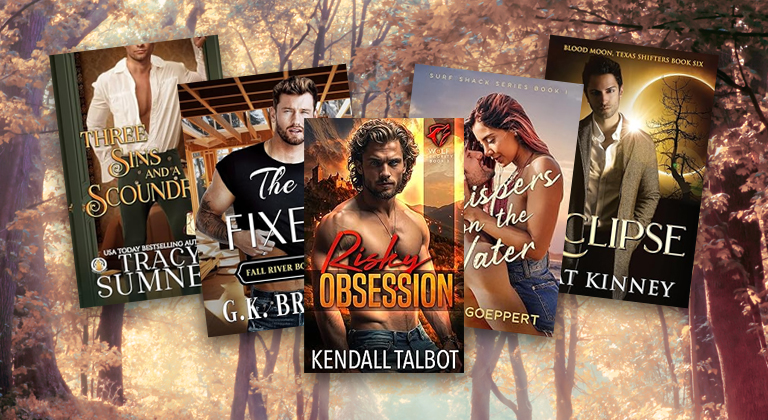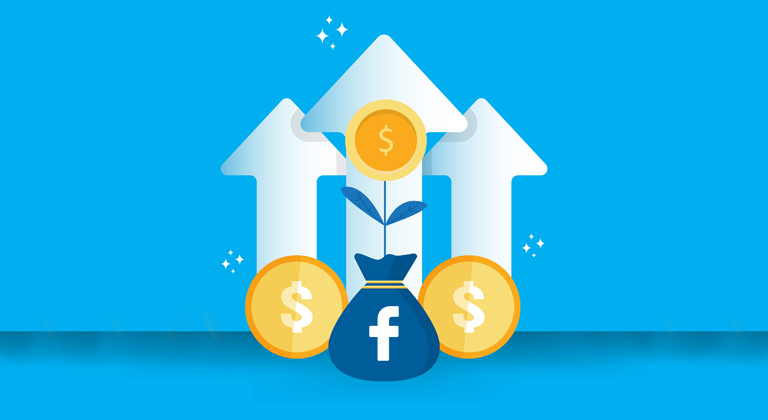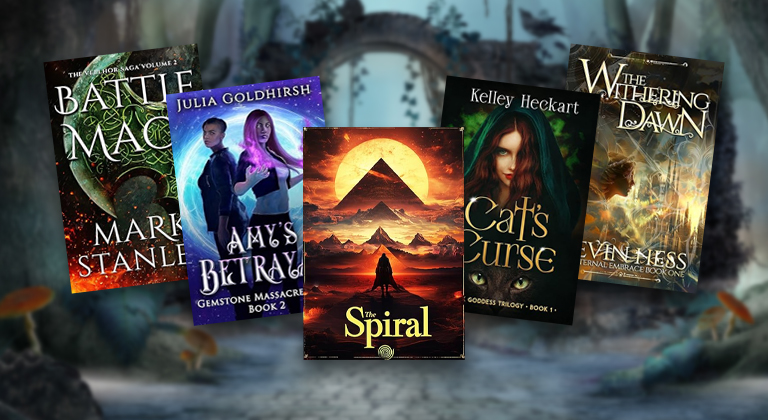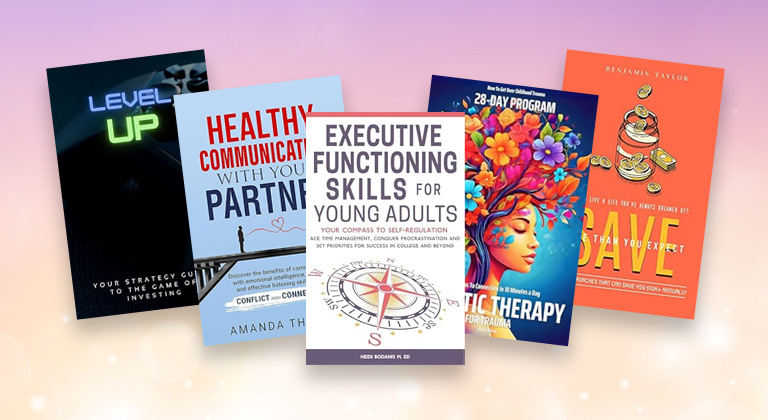The 30-day Social Media Challenge
One of the topics I discuss most often with authors looking for advice on expanding their readership is social media, because the importance of building a following cannot be overstated when it comes to self-publishing. There’s no one else to do it for you, so even if you shun social media in your personal life, you can’t afford to ignore it when it comes to your writing. That’s why advertising and marketing expert Ginger is here not only to challenge you into using your social, but he’s also handing out plenty of tips on how to do it effectively.
There’s probably nobody reading this who doesn’t know what NaNoWriMo is – the “national novel writing month” in which people commit to writing 50,000 words in 30 days, each November.
Well, successful self-published authors spend every month as if it’s NaNoWriMo – because of how important it is to write every day. So, instead, I’m going to present you with a different challenge – and you’ll be amazed at what happens at the end of it.
My challenge to you is this: Post on social media every single day for 30 days about your books.
Presumably, if you’re an author, you already have a social media presence.
Maybe it’s just your personal account on Twitter, or maybe you’ve already set up a Facebook Page, Instagram account and GoodReads for your penname. Either way – you’re about to start using them!
I’m recommending this because people underestimate just what a huge impact posting every day on social media can have – as long as the content you post is original, engaging, and optimized for the platform you’re posting on.
Not sure if yours is? You’ll soon find out!
Content is still king!
I was inspired to create this challenge after watching some videos by Gary Vaynerchuk on YouTube. “Gary Vee” is worth $160 million these days, and he credits a lot of it to social media.
In one video, he began by claiming: “Producing content on an everyday basis, at scale, is the answer to 99% of your questions.”
He’s absolutely right – but very few people take that advice seriously, even though it’s enabled Gary Vee to build $100 million businesses from scratch, in the space of time it would take most of us to earn a 4% increase in our salary.
We all have social media platforms – and often we writers will procrastinate from doing the writing that we need to by building these social media platforms – but then we’re left with blanks when it comes to actually posting something on them.
This is because social media is simple, but it doesn’t mean it’s easy. Coming up with ideas for social media posts is a demanding task. I worked in social media for years and used to call it ‘the sausage factory’ because it seemed like that’s all I was doing – producing content, day in and day out, and seemingly for nothing.
But it’s not for nothing!
A lot of people argue that social media offers a poor return on investment because it’s difficult to directly track sales, or traffic, or anything similar to what the whizkids of Facebook advertising and Advertising on Amazon will tell you (holds up hand awkwardly.)
Here’s the thing, though – it doesn’t matter.
Because the truth is, even Advertising on Amazon doesn’t give you the ability to truly see the value of your presence on the platform. People argue that you should be able to track the Average Cost of Sale (ACOS) and your page reads and see if your advertising is making a profit or not – but it’s really not that simple.
I recently compared a week of advertising on Amazon against one in which I didn’t advertise, and according to the dashboard on Amazon, the week was a failure. I spent $256.61 on advertising, and according to the dashboard, I made only $5.94 in book sales and $42.25 in KENP page reads.
However – I compared the actual sales for the week in Book Report and discovered that I’d made $426 more the week in which I’d advertised than the weeks in which I hadn’t; demonstrating that there was a link between simply being on the platform and making more money – even if you couldn’t directly track those sales.
Social media is exactly the same – only it goes one better: It’s free.
The Seven Touches
The reason this thing works is something I learned about 20 years ago when I was selling radio spots. The great advertising whiz Gif Gifford explained something called the ‘seven touches’ – which sounds really sketchy in our #metoo era.
However, these weren’t physical touches. He was referring to the number of times a potential customer is ‘touched’ by a sales message about your product.
He might wake up and see your ad in the paper while he’s drinking his coffee. He might listen to a commercial about it on the radio while he’s driving to work, and drive past a billboard that advertises your product. He might stop at the coffee machine and chat to a coworker who just bought that product – and then later that night, he might come home and see a commercial on television about it. Throughout the day, he’s ‘touched’ by your sales message seven times; until he finally decides to type the name of your product into Google and click ‘buy.’
According to the SEO nerds, that sale was generated by Google keywords and only Google keywords – but that’s not true. It was the seven ‘touches’ that led him to typing that into Google, and he wouldn’t have done so without being bombarded by your sales message so many times.
The same is true on Advertising on Amazon and Facebook. When was the last time you bought a product on Facebook? I recently purchased a home brewing kit – but I only clicked on the ad after seeing it pop up in my feed at least ten times previously.
The secret to advertising, you see, isn’t just clicks and conversions, but impressions. Every time a potential customer sees your product, it nudges them a little closer to clicking ‘buy now’ – but because you can’t trace the number of times they see your ad, it’s easy to dismiss the significance of these impressions completely.
In fact, the SEO industry exists almost exclusively because of that.
But it’s a mistake – and it’s also the opportunity.
Because with social media, you get to generate those impressions without having to pay for them. You just need to sacrifice something much more costly: Your time and your creativity.
Content that sticks
So as I said – social media is simple, but it isn’t easy.
The concept of posting to promote your books every day seems straightforward, but when an author sits down in front of the computer and faces a blank content calendar, it’s often just as intimidating as a blank page. It’s because you’re drawing from the same wellspring – creativity.
This is why a lot of authors fail when it comes to social media. If you head over to Twitter, you’ll see a lot of self-published authors posting the same graphic and the same message again and again – and then they’ll tell you “social media doesn’t work.”
But writing an engaging social media post is like writing an engaging book – not nearly as easy as outside observers think it is!
The art and science of making content go ‘viral’ is something that people have invested millions of dollars into trying to define – and largely failed. But there are a couple of guidelines which have always served me well.
There’s more to social media than selling your books.
The first mistake authors make on social media is to try and sell something with every post. Obviously, that’s the goal of your author identity having social media accounts in the first place – but posting nothing but sales messages doesn’t just fall flat, but actually turns potential customers off.
So, when you’re setting up your social media accounts, make sure that it’s easy for people to find your books if they’re interested – but other than that, keep direct sales messages to a minimum (and I’ll explain how to incorporate them momentarily.)
A good example is a link to your author page in the bio of your Instagram account. You can end a message “link in bio” if you’re directing people to your books – but you’re not shoving it in their face.
You can include sales messages – but include them like cracked black pepper on your scrambled eggs; a little goes a long way. A good rule of thumb is to have one outright sales message per four non-sales posts, or less – and make sure that sales message provides value (I’ll get to that later.)
Remember, a sales message is any time you ask somebody to do anything; even if it costs them nothing. That includes asking people to join your mailing list, fill in a survey, join your ARC team or even download your book for free! Keep these asks to a minimum, and make sure you have lots of interesting social content buffering them.
Create a Content Calendar
An easy way to avoid oversaturating your social media content with sales messages is to plan out an entire month’s content in advance. Now, if you’re like me – an ADHD nutcase who hates planning anything further in advance than dinnertime – this might sound like torture, but it can be REALLY useful if you’re going to be serious about it.
A content calendar is simply a month-at-a-glance calendar for the month, in which you plan out content in advance. If you’re going to post each and every day, and you want only 1 in 5 of your posts to be a sales message, you could start by writing “sales message” in every fifth box on your calendar.
Then you can start thinking of other kinds of posts that you can repeat – and plot those out, too. For example, I like to post pictures of the actors or models who inspired the ‘look’ of my characters, and so you can add one of those every week to your content calendar and you’ve already got two days of the week sorted.
The other advantage of doing this is that you can then schedule all these posts in advance – so you can leave your social media on autopilot and focus on writing your books instead!
Make sure all your posts provide value.
I mentioned earlier that your sales messages should “provide value” – but that should also be true of everything you post.
But what is “value’? Well, basically it’s anything that gives the reader something; even if it’s a cup of your morning coffee and a message: “Good morning! What have you got planned today?”
A smile has value – more than you can imagine – so simply making somebody smile is a good goal to set yourself.
I’m going to go into some good types of ‘valuable’ content momentarily, so let me just explain what I mean by that in the context of a sales message.
If you want your readers to take action on your sale message, give them an incentive. For example:
My NEW book is out this week, just 99c for a limited time or FREE on Kindle Unlimited.
In this message, you’ve got the incentive that this book is NEW (and new is exciting.) You’ve got the incentive that the price is reduced (“…just 99c!”) but a time constraint (“…for a limited time!”) to get them to take action now. Finally, you’ve got those magic letters – FREE – and that’s a powerful word even if the reader doesn’t have a Kindle Unlimited account.
I mentioned earlier that even asking somebody to download your ‘free’ book is a sales message, but sales messages are effective if they demonstrate the additional value that this offer provides.
I’ll go into this in a little more depth in a later blog post – but for now just keep it in the back of your mind: Always provide value.
Be unapologetically authentic…
One of the other reasons authors don’t succeed on social media is because they’re scared to be themselves. I mentioned earlier the idea of a picture of a cup of coffee and the message: “Good morning! What have you got planned?” I’ve heard authors scoff at that – “who wants to see that?”
Well, your readers do!
I once got into an argument with some big, corporate type when I pointed out that the Twitter account for their $100 million corporate behemoth had fewer followers than my teenage son’s Twitter account – to which they responded: “Well, personal accounts always have more followers.”
Bollocks! Coca-Cola has 107 million followers on Facebook – and they didn’t get them all through advertising. They got them by posting interesting, engaging content – just like you should.
But there is something to learn about why it’s easy to get followers on a personal account, but difficult to get traction with your author profiles: Authenticity.
People with personal accounts post pictures of their dogs, or their coffee, or links to articles they find interesting, or they tag their friends, who drive their friends to follow them. They’re just… them.
They’re not worried about trying to sell something with every post. They’re just posting because things interest or engage them – and those are the things that interest or engage other people. So, don’t overthink it!
Seriously – if you’re having a cup of coffee; post it! If you’re going to see a movie (ha! pre-Covid reference!) post it! If you’ve read a book – post it! Post what interests and engages you, because the chances are that these are the things that interest and engage the kind of people who’ll want to read your books (because these are things that will filter into your writing, even if you don’t realize it.)
Don’t be afraid to be yourself – because that’s the only way you’ll engage with followers and turn them into readers.
…except about politics. Or religion.
Okay, you can be yourself – but don’t be yourself.
Recently, J.K. Rowling got into hot water for posting her controversial thoughts about transgender people. Stephen King gets attacked for all the stuff he posts criticizing Trump. These might be opinions you hold, but the edgier they get, the less your readers want to hear about them.
I read J.K. Rowling books because of wizards and adventure – I don’t care about her opinion on transgender people. Likewise, Stephen King is the seminal author of his generation; but I don’t want to listen to him drone on about politics.
It’s not that they both don’t have the right to – it’s just that focusing on drama, controversy, and negative things is not a good experience for a potential reader. I know plenty of Trump-hating fans of Stephen King, for example – but I don’t know of a single person who read his books because of his political positions.
Likewise, nobody is going to pick up the Harry Potter series because J.K. Rowling wowed them with her opinions on transgender rights; but I know dozens of Harry Potter fans who won’t read another word of hers because of what she’s said.
Be authentic, but be positive, or neutral, or real. You can post about how you’ve got a scary doctor’s appointment tomorrow, or you’re sad that your dog died, or anything human and emotional – but only if it’s human and emotional.
…and just to contradict myself, if you’re truly passionate about some issues, and they are a defining part of your writing, feel free to ignore all of the above. I’ve started reading a number of black authors because I met them through BLM posts and content, so if your content is irrevocably linked to something controversial or political, ignore all of the above.
Ask for a response.
The most successful Twitter post I ever made was “coffee or tea?”
Three words – and dozens of responses within the first few hours.
Ask a question, or type ‘hit that like button’, and followers will be more likely to take action. Once they’ve taken action, your presence is served to them more often by the social media algorithms. Engagement is the secret sauce to social media success, so ask or post something that gives them an opportunity to respond.
Engage with your followers.
Likewise, the moment you engage with your followers, you go from strangers to friends. If somebody leaves a comment on your Facebook page – respond. If somebody likes one of your posts – respond.
Being responsive shows your followers that you’re real, and that you care about them. There should always be some distance between you as an author and a fan; but creating a relationship with your followers is what turns followers into readers, and then readers into fans.
Share other people’s content.
This one is a difficult one for people to get their head around – but it works.
Tag other authors you know and read. Recommend their books. If a follower leaves a comment, respond – and then follow their account. If you see a cool article, share it and tag the magazine you found it in.
Connecting your posts to other people, and creating those spiderwebs between you and a larger audience, all comes from sharing the love.
There is literally no downside to this. If your author friend is releasing a book, you’re not going to lose sales by sharing their post about it. If you like a band, you’re not going to lose followers by tagging them when you share their latest music video. Share, share, share – and each time you do, you sink roots into the social media ecosystem that will help nurture your own presence online.
Make it easy on yourself.
If all of this sounds like hard work – start small.
When I created a social media account for my MC romance penname, I never knew what to post; so I kept it simple.
Every time I saw a Harley-Davidson in the wild, I’d snap a picture of it and post it. It was that straightforward.
It meant I put something up every couple of days; and just like you’ll discover with this 30-day social media challenge, that’s often all it takes to start seeing some traction.
It’s a learning experience.
If you post on social media every day for 30 days, you’ll see things happen. You might not become the next Lee Child – but something will happen.
More than that, though – you’ll learn the discipline of creating and posting content, and you’ll start to learn what sticks and what doesn’t.
Why is this valuable? Because these rules will apply when you finally start spending money on advertising your books. You’ll begin to know what your followers like, and you can also use all this engagement to define audiences on platforms like Facebook.
There is literally no downside to this challenge – except having to overcome whatever hurdle is holding you back.
In any event, I’m posting every day for the next 30 days, and I’ll be sure to report back to tell you how it impacted my career as a writer.












2 Comments